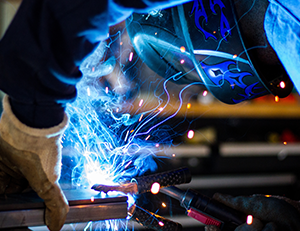What Is Welding
Welding is a fabrication or sculptural process joining together two or more metal or thermoplastic parts by heating the surfaces to the point of melting with a blowpipe, electric arc, or other means, and uniting them by pressing and hammering. In the context of metal fabrication, the process fuses and permanently joins the two parent metals.
 The Origins of Welding
The Origins of Welding
A boilermaker is a trained tradesperson who produces steel fabrications from plates and tubes. The name originated from craftsmen who would fabricate boilers, and the trade of boilermaker evolved from the industrial blacksmith and was known in the early 19th century as a “boilersmith”. These days they may work on projects as diverse as bridges to blast furnaces to the construction of warehouse and mining equipment.
Types of Welds
There are four common types of welds:
1. TIG Welding (Gas Tungsten Arc Gas Welding – GTAW/TIG)
TIG welding, otherwise referred to as gas tungsten arc welding, is one of the most popular welding processes. It produces high quality welds but also required a high level of skill. In TIG welding, the welder makes an arc between the base metal and the non-consumable tungsten electrode, a type of electrode that does not melt. At the point where the arc hits the base metal a molten weld pool forms. A thin wire of filler metal is slowly handfed into the weld pool, where it melts.
2. MIG Welding (Gas Metal Arc Welding – GMAW/MIG)
MIG welding is a welding process in which an electric arc forms between a consumable wire electrode and the work piece. This process uses inert gases or gas mixtures as the shielding gas. Argon and helium are typically used for the MIG welding of non-ferrous metals such as aluminium. MIG welding is the most accessible option for doing high-quality work with stainless steel. When MIG welding stainless steel, you’ll need to use a shielding gas to protect the workpiece from contamination.
3. SMAW Welding (Shielded Metal Arc Welding – SMAW)
With SMAW welding, the welder follows a manual process of stick welding. The stick uses an electric current to form an arc between the stick and the metals to be joined. This is often used in the construction of steel structures and in industrial fabrication to weld iron and steel.
4. Flux Cored Arc Welding (FCAW)
FCAW welding was developed as an alternative to shield welding. The semi-automatic arc weld is often used in construction projects, because of its portability and high welding speed.
Why Welding is an Expert Skill
Welding is an expert skill and many forms of construction, warehousing and transportation rely on quality welding for equipment and personnel safety. Welding is so important to safety and structural integrity that welders are required by law in Australia to meet specific welding safety standards to guarantee a minimum level of quality.
Welding Qualifications
Welders in Australia are required to complete their Boilermaker qualification (Certificate 3 in Boilermaker / Welding), and professional welders who specialise in fabrication welding are also obliged to comply with Australian Certification Code AS1554. This certification guarantees the highest standard of metal fabrication welding.
Welding Procedures
Welders must ensure that preparations, procedures and safety precautions are followed before welding takes place and must then follow steps to perform a particular welding job.
All fabrication and welding work must be completed using qualified procedures. Even basic material handling equipment such as a gas bottle trolley or picking trolley needs to follow the correct specifications.
A key component is a Welding Procedure Specification (WPS), a document that details all the settings the welder needs to use, ensuring that the standard is met, regardless of who does the job.
Welder Qualification Records (WQR) are also provided as evidence that the welder has been tested adequately to the provided WPS.
Weld Testing and Inspection Requirements
A visual weld inspection is the easiest and least-expensive method for inspecting a weld. However, a carefully inspected and good-looking weld doesn’t always ensure internal quality, and discontinuities aren’t always visible to the naked eye. Additional methods are available, including surface crack detection, destructive weld testing and radiographic and ultrasonic weld inspection.
Under AS1554.1, welding must be subjected to testing and inspection. This applies to both onsite and factory fabrication work. One small flaw – even if it is too small to see – can be dangerous. This is why ethical practice demands that every lifting weld point should be tested, and this is why International Standards such as the ISO 9934 series guide the different ways this should be done. Mag Particle Testing your Welds is an important aspect of this safety and weld testing.
The Importance of Welding in Modern Life
Welding is an essential part of modern life and fundamental to many of our important industries including construction, aviation, automobiles and manufacturing. Without welding buildings, airplanes, industrial equipment, appliances, and cars wouldn’t exist.
At Bremco Metal, we understand the importance of quality welding and our expert welders deliver the highest quality, fully welded materials handling equipment for the construction, manufacturing, warehouse, mining and transport industries. All of our custom-manufactured products whether it be a metal pallet cage, gas bottle storage cage, or lifting beam, are all subjected to intense quality checks in line with Australian Standards.
